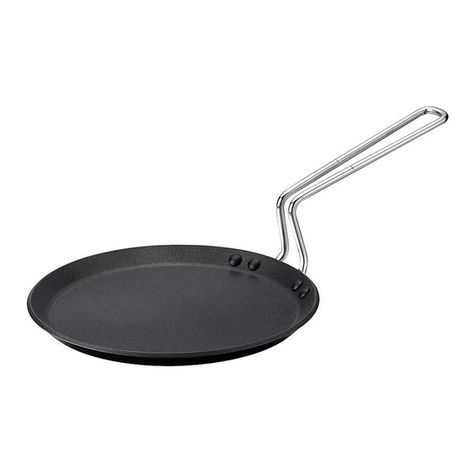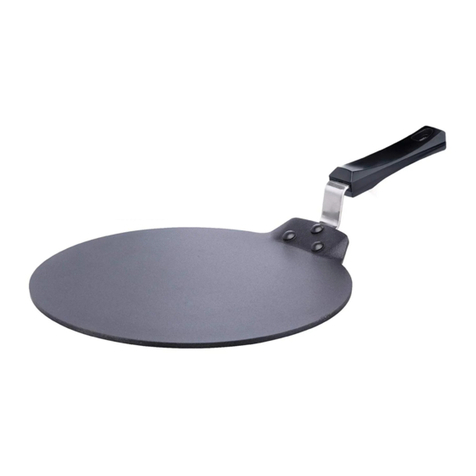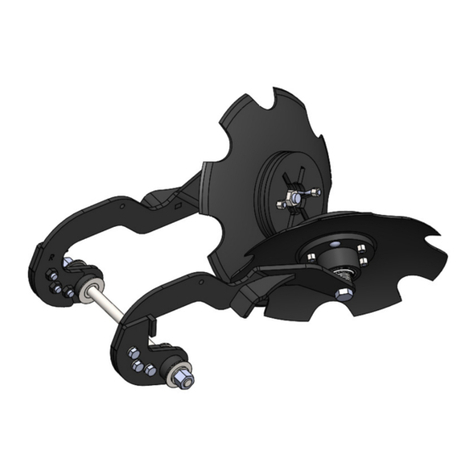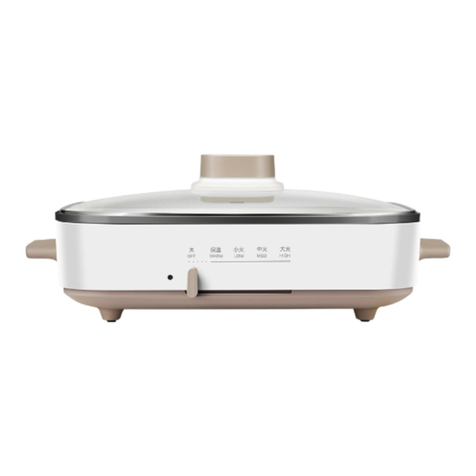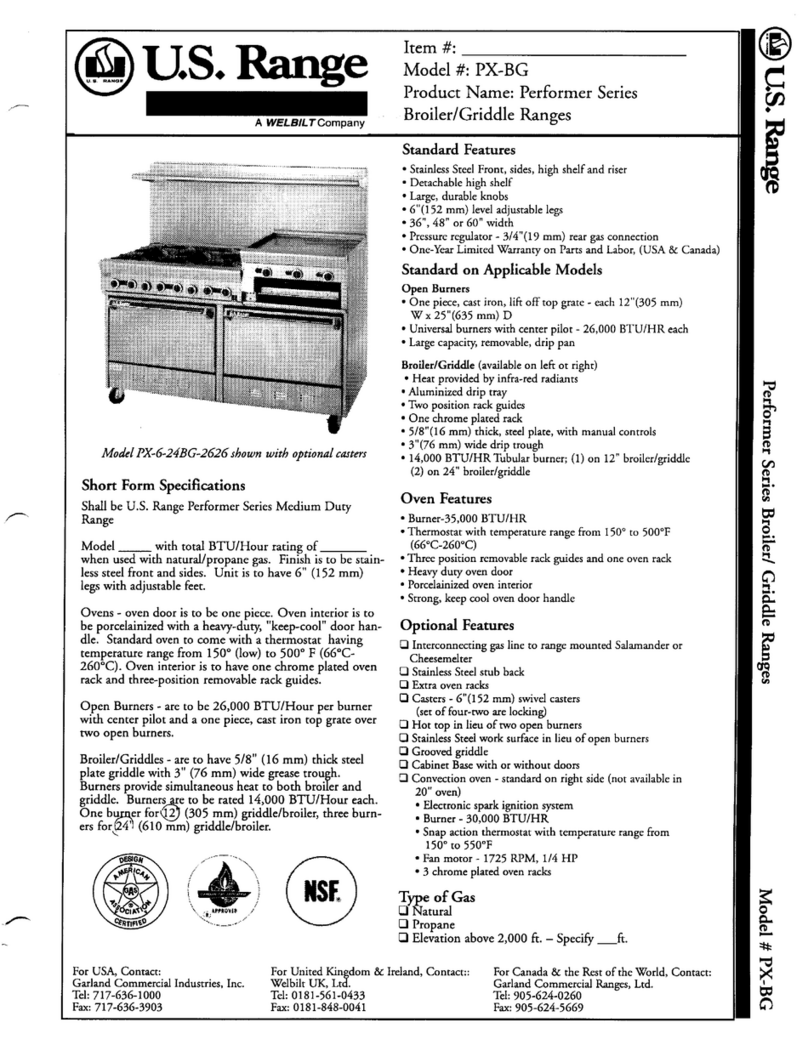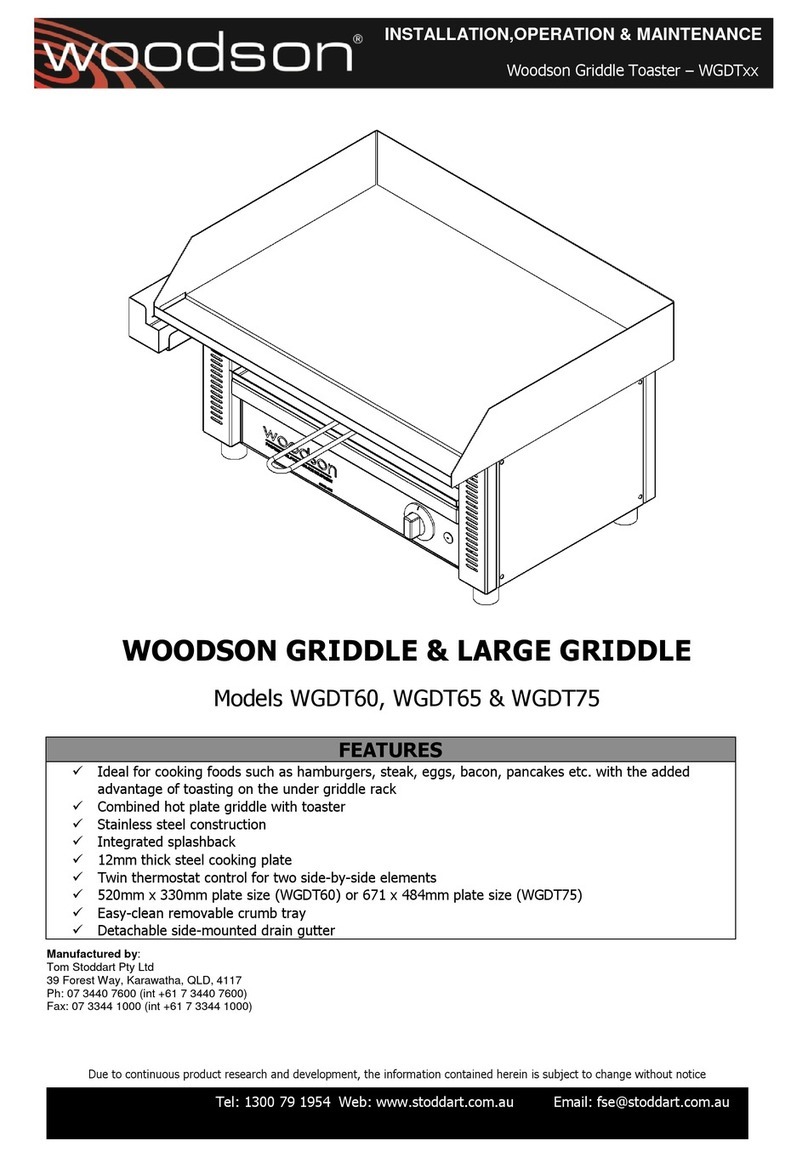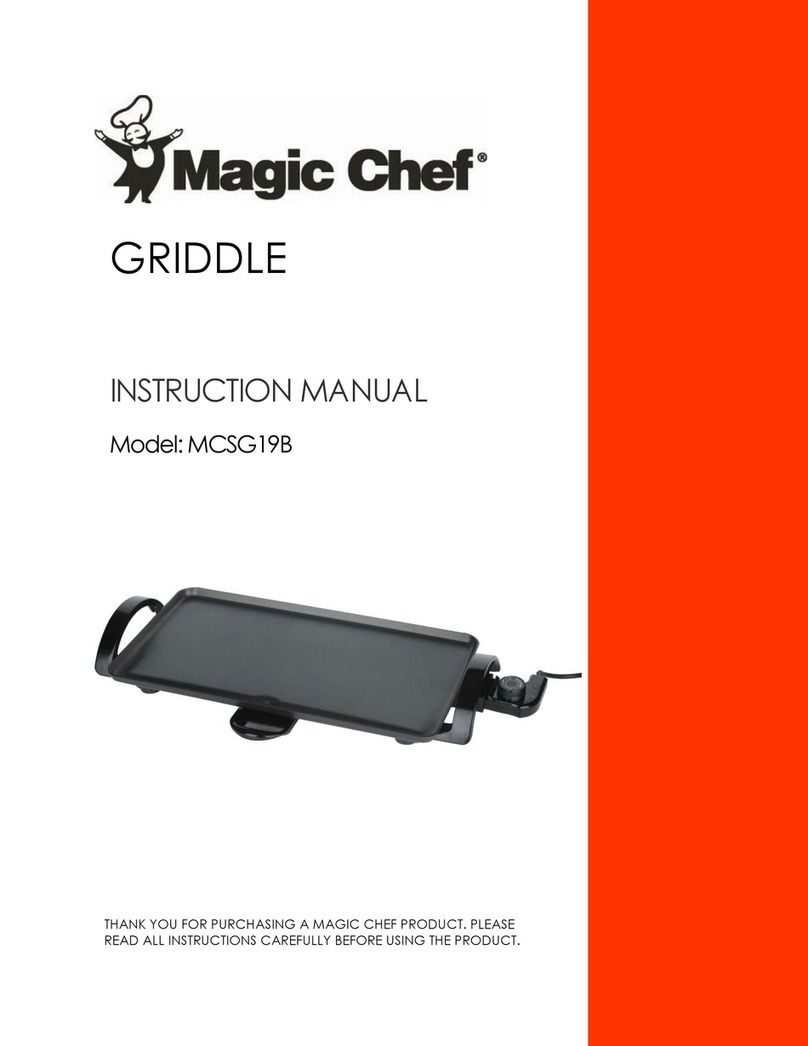Hawkins Futura Hard Anodised Flat Tuva Griddle User manual


1
IMPORTANT SAFEGUARDS
1. Always give careful attention to a hot tava,
hot oil and flame/heat.
2. The handle of tava should be parallel to the
kitchen counter – not sticking out.
3. Do not leave frying unattended.
4. Do not drop food or other objects from a height
on the tava particularly when it has hot oil or
butter. Gently place food on the tava to avoid
splashing of the contents.
5. Do not put tava with plastic handle in a hot
oven or under a broiler as the plastic handle
may get damaged. Tava with stainless steel wire
handle can be put in an oven or under a broiler
– remember to use a pot holder on the
IF YOU HAVE ANY QUESTIONS, COMMENTS
OR SUGGESTIONS OR IF YOU NEED ANY
HELP WITH THIS PRODUCT OR WITH ANY OF
OUR OTHER PRODUCTS, PLEASE CONTACT
THE CONSUMER SERVICE MANAGER AT:
Hawkins Cookers Limited
P O BOX 6481, MUMBAI 400 016, INDIA
TEL (91 22) 2444 0807 FAX (91 22) 2444 9152
EMAIL [email protected]
handle when it is hot.
6. Do not bang or hit the product hard with any
hard or sharp object. Do not cut or chop on
tava with a metal knife or sharp object.
7. Do not put hot tava in cold water.
8. Do not wash tava in a dishwasher.
9. This tava is not nonstick – it is hard anodised.
Some foods will require some oil or water or
careful control of heat to prevent sticking.
10. The tava heats quickly and retains heat well.
Do not heat excessively as this may cause
burning and sticking of food.
11. Read and follow instructions in this Manual.
®

2
Introduction
Futura Hard Anodised Cookware
Futura Hard Anodised Cookware is made from heavy gauge, pure,
virgin aluminium for fast and even heat conduction and hard anodised
to give you a tough surface that will not pit, tarnish or corrode and will
stay looking new for years. Futura Hard Anodised Cookware comes in
many useful shapes and sizes to suit your different cooking needs. All
pans are well-balanced with sturdy, stay-cool handles.
Futura Hard Anodised Flat Tava (Griddle)
This Manual contains instructions and 10 recipes for the two Futura
Hard Anodised Flat Tava (Griddle): 26 cm diameter with stainless steel
handle and 26 cm diameter with plastic handle. Your tava will give you
years of easy, great-tasting cooking and easy clean-up if you carefully
follow the instructions in this Manual.
Contents
Page
Important Safeguards 1
How to Contact Us 1
Introduction 2
How to Use 3
How to Clean 3
Easy Tips for Better Cooking 4
How to Cook Paratha 5
Measurements 5
Recipes
Paratha (Layered Unleavened Bread) 6
Uttapam (Savoury Rice and Gram Pancakes) 7
Dosa (Rice and Gram Pancakes) 7
Fried Eggs 8
Rawa Dosa (Semolina and Gram Pancakes) 8
Coconut Chutney 9
Alu Tikki (Potato Cutlets – Sindhi Style) 9
Alu Paratha (Unleavened Bread Stuffed with Potatoes) 10
French Toast 11
Pancakes 11
Glossary (Meanings and Methods) 12
’HAWKINS’ AND ‘FUTURA’ ARE REGISTERED TRADEMARKS IN 18 AND 23 COUNTRIES RESPECTIVELY. PRODUCT DESIGN REGISTERED IN INDIA. 2004 COPYRIGHT RESERVED BY HAWKINS COOKERS LIMITED.
EDITED AND PUBLISHED BY BRAHM VASUDEVA ON BEHALF OF HAWKINS COOKERS LIMITED, MAKER TOWER F-101, CUFFE PARADE, MUMBAI 400 005, INDIA. PRINTED IN 2004 AT RITE PRINT PAK, MUMBAI.

3
How to Use
Before First Use
Remove sticker/label. Remove any adhesive that may be left by the
sticker with baby or vegetable oil. Wash in hot water with a soap or
mild detergent; rinse in clear water and dry. Do not wash in a dishwasher.
Suitable Heat Sources
Tava can be used on domestic gas, electric, kerosene or halogen
stoves. Do not use tava on a coal fire or any source that cannot be
regulated. Ensure that the stove surface in contact with the tava is free
of grease and dirt.
Regulate Heat
Futura Tava conduct heat evenly and efficiently so high heat is rarely
necessary. When preheating tava on high heat, do not lose track of
time so that it becomes too hot. To achieve good results, regulate the
heat used with the tava.
Prevent Sticking
Some foods will require some oil or water or careful control of heat
to prevent sticking. See Easy Tips for Better Cooking page 4, para 7
and 8.
Avoid Scratching, Damage
Do not cut or chop on tava with a knife or other sharp instrument
such as the edge of a metal spatula. Do not drop tava or bang it with
hard or sharp objects.
Do not bang tava on pan supports. Do not drag tava across the pan
supports – lift it.
Do not put tava with plastic handle in a hot oven or under a broiler
as the plastic handle may get damaged. Plastic handles can break
under a sharp or forceful blow – handle with care.
How to Clean
Avoid “Baked-On” Food
If tava is not cleaned thoroughly, a thin layer of food or grease may
remain. When the tava is heated next this food/grease becomes
“baked-on” and very difficult to remove. “Baked-on” food may be
impossible to remove without damaging the tava.
Wash After Every Use
Always wash tava thoroughly after every use in hot water with a
soap or mild detergent and a dishcloth, sponge or plastic scrubber. Do
not wash tava in a dishwasher. Let tava cool before immersing in water.
For stubborn spots, soak tava in hot water about 10 minutes and rub
with a plastic scrubber. While cleaning, keep a folded kitchen cloth or
a piece of soft material such as rubber or sponge underneath the tava
to avoid damaging the tava. Dry thoroughly with a soft clean cloth. Do
not store food on your tava.
To make cleaning much easier, immediately after cooking while
the tava is still hot, wipe off residual oil with a folded paper napkin or
cloth sufficiently thick to protect your hand from the hot metal and oil.
Metallic marks from pan supports may appear on the base. To
remove such marks: apply a kitchen cleanser, such as ‘Vim’, to the
marks and rub with an abrasive kitchen scrubber, such as ‘Scotch-Brite’
or fine steel wool.
If you get “baked-on” food, you may try the following method
knowing that the tava surface may get damaged: make a thick paste of
a cleaning powder such as ‘Vim’ and apply it to the “baked-on” food.
Wait 5 to 10 minutes. Scour with steel wool using a circular motion.
Wash.

4
Easy Tips for Better Cooking
1. Read the entire recipe before beginning to work. Assemble and
prepare all ingredients. Follow recipe step-by-step.
2. Information on weights and measures is on page 5.
3. Unless otherwise noted, in the recipes:
•All foods are to be appropriately cleaned and washed.
•Onions are to be peeled.
4. For Users Outside India: In the recipes, size descriptions of
ingredients refer to food available in India. Outside India, follow the
weights rather than the size descriptions.
5. All Hindi words used in the recipes, if not translated in the recipes,
are translated to English or explained in the Glossary (Meanings and
Methods) on page 12. If you come across a word you do not know,
check Glossary page 12.
6. Time and heat settings in these recipes refer to the large burner of
an efficient domestic gas stove. You may have to adjust these times and
settings to suit your stove. For best cooking results, adjust the heat so
that cooking times are the same as those given in the recipes. You will
be helped in making these adjustments by the steps and indications
given in various recipes (for example, a few light brown specks should
appear on the underside of a paratha after 1 minute on medium heat).
7. Excessive heat may cause sticking and burning of food and wastes
fuel.
8. To prevent sticking of foods such as dosa, uttapam and poora
on the tava: before heating tava, rub 1/4 tsp
/
1.3 ml vegetable oil using
a clean cotton cloth or paper napkin all over the inside base of tava.
Heat tava on medium-high heat till oil just begins to smoke. Reduce
heat to medium. This is the point to pour batter on tava. Heating tava
to the correct temperature is critical: if tava is heated beyond the point
when oil just begins to smoke, tava will be too hot and batter will be
difficult to spread; if tava is not hot enough (before oil just begins to
smoke) batter will spread but dosa/poora will stick. For cooking
subsequent dosa/poora do not add oil on tava before pouring batter.
9. Ghee, butter or oil can be spread on tava with a pastry brush or
spatula.
10. The quantities of green chillies recommended in the recipes are
calculated to produce food of moderate pungency. You may increase,
reduce or eliminate the chillies according to your taste.
11. Do not leave tava unattended while cooking as cooking times are
short and food may burn.
12. It is possible to cook with less ghee or butter than given in the
recipes or substitute oil for ghee or butter. However, this may affect the
taste.
13. Eggs require controlled heat or they may become tough. Eggs
should be cooked on low to medium temperatures.
14. Certain recipes specify “medium-high” or “medium-low” heat
setting. By “medium-high” we mean a setting between medium and
high. By “medium-low” we mean a setting between medium and low.
15. Eggs, batters, doughs and fillings should be at room temperature
before beginning to cook.
16. To prevent sticking when rolling out rounds of dough: slightly
flatten balls and press the balls/coils lightly in flour on both sides.
Shake off excess flour and roll out.
17. While cooking on tava, paratha and phulka leave a residue of flour
that will burn. Using a kitchen cloth, wipe off accumulated residue
after every third roti.

5
Measurements
Volume
All measurements are level, not heaped.
Measurement Equivalent
1 teaspoon 5 ml
1/2tablespoon 11/2 teaspoons
/
7.5 ml
1 tablespoon 3 teaspoons
/
15 ml
1/4cup 4 tablespoons
/
60 ml
1/3cup 5 tablespoons +
1 teaspoon
/
80 ml
1/2cup 8 tablespoons
/
120 ml
3/4cup 12 tablespoons
/
180 ml
1 cup 16 tablespoons
/
240 ml
Weight
Metric Equivalent
28 g 1 oz
450 g 16 oz
/
1 lb
1 kg 2.2 lb
Length
Measurement Equivalent
1/4 inch 6 mm
1/2 inch 1.3 cm
3/4 inch 1.9 cm
1 inch 2.5 cm
Abbreviations
Abbreviation Equivalent Abbreviation Equivalent
tsp teaspoon lb pound
tbsp tablespoon g gram
ml millilitre mm millimetre
oz ounce cm centimetre
Measurements of ghee in the recipes are for ghee at room
temperature.
How to Cook Paratha
THESE INSTRUCTIONS ARE TO BE USED AS INDICATED IN THE RECIPES.
Paratha take about 4 minutes to cook; stuffed paratha take
about 5 minutes.
1. Put round on preheated tava. Cook 1 minute. (Top should begin to
look dry and darken. There should be a few light brown specks on the
underside. If you can adjust the heat so that a few brown specks
appear on the underside in 1 minute, you will be cooking at the ideal
temperature.) Turn over round with a broad spatula.
2. Spread 1/2tsp
/
2.5 ml ghee all over top surface of round. Turn over.
3. Spread 1/2tsp
/
2.5 ml ghee in the same way. Turn over.
4. Lightly press entire round with spatula, rotating and pressing a
small area at a time. (Pressing paratha ensures even cooking. If you
notice a lighter area, press on the opposite side of that area when you
have turned over paratha.) Turn over.
5. Press in the same way. Turn over.
6. Spread 1/2tsp
/
2.5 ml ghee over round. Turn over.
7. Spread 1/2tsp
/
2.5 ml ghee over round. Turn over.
8. Continue pressing and turning till paratha is evenly browned
(medium-brown) on both sides. Remove.
9. For instructions on how to stuff paratha: see page 10.

6
Paratha (Layered Unleavened Bread)
Yield: 12 paratha
6 cups
/
600 g sifted wheat flour
11/4tsp
/
6.3 ml salt (optional)
2cups + 4 tsp
/
500 ml water
1/2cup + 2 tbsp
/
150 g ghee
1. Mix flour, salt and 11/2cups
/
360 ml water. Add enough of remaining
water (1/2cup + 4 tsp
/
140 ml), 2 tbsp
/
30 ml at a time, mixing after
each addition, till dough forms a soft ball (stop adding water before
dough becomes wet and sticky). Knead till dough is smooth and
elastic (about 2 minutes). Keep covered with a damp cloth about
30 minutes.
2. Rub
hands with a little ghee. Knead dough briefly. Make
12 balls about 13/4 inch
/
4.5 cm in diameter. Keep covered with a damp
cloth.
3. On a floured board, roll a ball of dough into a flat round 71/4inch
/
18 cm in diameter (see page 4 para 16). Spread 1/2tsp
/
2.5 ml ghee all
over the top surface of the round.
4. Starting at one edge, tightly roll up round (Figure A). With palms of
both hands roll back and forth till extended to 91/2inch
/
24 cm long
(Figure B). Wind around one end into a flat coil (Figure C). Put free end
over centre top of coil (Figure D). Press down free end gently. Flatten
coil slightly.
5. Make remaining balls into coils in the same way as given in step 3
and step 4. Keep covered with a damp cloth.
6. On a floured board, roll each coil into a flat round 71/4inch
/
18 cm
in diameter. Keep on a lightly floured surface, covered with a damp
cloth.
7. Heat tava on medium heat about 3 minutes.
8. Put round on tava. Cook as explained on page 5.
9. Remove paratha from tava. With paper napkins or cloth protecting
both hands, cup hands around paratha and quickly bring together
(crushing paratha) and release. Rotate paratha 90 degrees. Repeat
crushing. Cook remaining rounds in the same way. Serve hot. •
Figure A Figure B Figure C Figure D

7
Uttapam (Savoury Rice and Gram Pancakes)
Yield: 7 uttapam
2 cups
/
400 g rice
1 cup
/
200 g urad dal
11/2 cups
/
360 ml water other than for step 1
1 tbsp + 1 tsp
/
20 ml salt
2 medium (81/2oz
/
240 g) onions
finely chopped
5green chillies chopped
3 tbsp
/
45 ml coriander leaves chopped
31/2 tbsp + 1/4 tsp
/
54 ml vegetable oil
1. In separate bowls, cover rice and urad dal with water at least
1 inch
/
2.5 cm above ingredients. Soak 4 hours. Drain.
2. Grind rice into a paste, gradually adding 2/3 cup
/
160 ml water.
3. Grind dal into a paste, gradually adding remaining water (3/4cup +
4 tsp
/
200 ml).
4. In a large bowl, mix rice and dal pastes and salt to make batter.
Cover and keep aside (not in a refrigerator) at least 12 hours to ferment.
5. Mix fermented batter and all other ingredients except oil.
6. Rub 1/4 tsp
/
1.3 ml oil all over the inside base of tava using a clean
cotton cloth or paper napkin. Heat tava on medium-high heat till oil
just begins to smoke (about 4 minutes). Reduce heat to medium.
Heating tava to the correct temperature is critical (see page 4 para 8).
7. Stir batter and pour 1 cup
/
240 ml in centre of tava. With the back
of a rounded ladle, quickly and gently spread batter to make a round of
even thickness about 71/2 inch
/
19 cm in diameter. Add 1/2 tsp
/
2.5 ml
oil mainly on uttapam all around its edge, letting some oil flow onto
tava. Fry till surface appears dull and underside is golden brown (about
3 minutes). Dribble 1 tsp
/
5 ml oil all over uttapam. Turn over. Fry till
underside is golden brown (about 3 minutes). Remove. Fry remaining
uttapam in the same way except do not add oil on tava before pouring
batter. Serve hot, accompanied with Coconut Chutney (for recipe, see
page 9). •
Dosa (Rice and Gram Pancakes)
Yield: 21 dosa
11/2cups
/
300 g rice
1/2cup
/
100 g urad dal
11/2cups + 21/2tbsp
/
400 ml water other than for step 1
2tsp
/
10 ml salt
7 tbsp + 1/4 tsp
/
107 ml vegetable oil
1. In a bowl, cover rice and urad dal with water at least 1 inch
/
2.5 cm
above ingredients. Soak 4 hours. Drain.
2..
..
. Grind rice-dal mixture into a paste gradually adding 11/4 cups
/
300 ml water.
3. In a large bowl, mix rice-dal paste and salt. Cover and keep aside
(not in a refrigerator) at least 12 hours to ferment.
4. Mix fermented paste and enough of remaining water (1/4 cup +
21/2 tbsp
/
100 ml) to make a thin batter.
5. Rub 1/4 tsp
/
1.3 ml oil all over the inside base of tava using a clean
cotton cloth or paper napkin. Heat tava on medium-high heat till oil
just begins to smoke (about 4 minutes). Reduce heat to medium.
Heating tava to the correct temperature is critical (see page 4 para 8).
6. Stir batter and pour 3 tbsp
/
45 ml in centre of tava. Quickly place
the back of a rounded ladle very lightly on batter. Using a continuous
circular motion in one direction, gently spread batter evenly outwards

8
Rawa Dosa (Semolina and Gram Pancakes)
Yield: 25 dosa
3/4 cup
/
150 g urad dal soaked for 2 hours
and drained
3cups + 2 tbsp
/
750 ml water
2 cups
/
300 g rawa
2tsp
/
10 ml salt
1/4 tsp
/
1.3 ml vegetable oil
1/2cup + 1 tsp
/
110 g butter melted
1. Grind urad dal
into a paste gradually adding 11/4cups
/
300 ml water.
2. Put rawa in a large bowl. Gradually add remaining water (13/4 cups
+ 2 tbsp
/
450 ml), stirring constantly to make a smooth batter. Add
dal paste and salt. Mix. Cover and keep aside (not in a refrigerator) at
least 12 hours to ferment.
3. Rub oil all over the inside base of tava using a clean cotton cloth or
paper napkin. Heat tava on medium-high heat till oil just begins to
smoke (about 4 minutes). Reduce heat to medium. Heating tava to the
correct temperature is critical (see page 4 para 8).
4. Stir batter and pour 3 tbsp
/
45 ml in centre of tava. Quickly place
the back of a rounded ladle very lightly on batter. Using a continuous
circular motion in one direction, gently spread batter evenly outwards
from centre to make a round about 71/2 inch
/
19 cm in diameter. Add
1/2 tsp
/
2.5 ml butter mainly on dosa all around its edge, letting some
butter flow onto tava. Dribble 1/2 tsp
/
2.5 ml butter all over dosa. Cook
about 2 minutes. Turn over. Cook 1 minute. Remove. Cook remaining
dosa in the same way except do not add oil on tava before pouring
batter. Serve hot, accompanied with Coconut Chutney (for recipe, see
page 9). •
from centre to make a round about 71/2inch
/
19 cm in diameter. Add
1/2 tsp
/
2.5 ml oil mainly on dosa all around its edge, letting some oil
flow onto tava. Dribble 1/2 tsp
/
2.5 ml oil all over dosa. Cook about
2 minutes. Turn over. Cook 1 minute. Remove. Cook remaining dosa in
the same way except do not add oil on tava before pouring batter. Serve
hot, accompanied with Coconut Chutney (for recipe, see
page 9).
•
Fried Eggs
Yield: 4 eggs
4eggs
1 tbsp
/
15 ml butter
a large pinch salt
a large pinch pepper
1. Break 2 eggs on a saucer. Repeat with another saucer.
2. Heat tava on low heat about 2 minutes. Spread butter to cover
inside base of tava. Slide eggs onto tava. Increase heat to medium-low.
Cook about 2 minutes or to desired doneness. Sprinkle salt and pepper.
Serve hot. •

9
Alu Tikki (Potato Cutlets – Sindhi Style)
Yield: 12 tikki
4 slices bread
(each 31/4 inch x 31/4 inch x 3/8 inch
/
8 cm x 8 cm x 1 cm)
1 cup
/
240 ml water
6 medium (1 lb 5 oz
/
600 g) potatoes ‘boiled’ (see page 12),
peeled and mashed while still
hot
2green chillies finely chopped
2 tbsp
/
30 ml coriander leaves finely
chopped
11/2tbsp
/
22.5 ml mint leaves finely chopped
11/2 tsp
/
7.5 ml salt
1/2tsp
/
2.5 ml red chilli powder
1 tsp
/
5 ml cumin seeds
3 tbsp
/
45 ml vegetable oil
1. Immerse each bread slice in water for 15 seconds. Squeeze out and
discard water. Break bread into tiny pieces. Mix bread and all other
ingredients except oil. Make 12 patties about 23/4inch
/
7cm in diameter,
1/2 inch
/
1.3 cm thick.
2. Heat 11/2 tbsp
/
22.5 ml oil on tava on medium heat about 3 minutes.
Spread oil on tava all over the area where the patties will be placed.
3. Add 6 patties. Fry on both sides till golden brown (about 3 minutes
on each side), if necessary tilting tava to spread oil around tikki. Remove.
4. Spread remaining oil (11/2 tbsp
/
22.5 ml) on tava. Fry remaining
patties in the same way as in step 3. Serve hot, accompanied with
chutney or tomato ketchup.
•
Coconut Chutney
Yield: 2 cups
1/2 cup
/
80 g groundnuts
2 cups
/
160 g coconut grated
2/3 cup
/
160 ml curd beaten
6green chillies
2tsp
/
10 ml salt
1 tsp
/
5 ml sugar
1/4cup
/
60 ml water
Tempering
1 tbsp
/
15 ml vegetable oil
1 tsp
/
5 ml mustard seeds
1 tsp
/
5 ml urad dal
12 small curry leaves
1. Put groundnuts on tava on medium heat. Stir constantly till
groundnuts start crackling (about 5 minutes). Remove from tava.
Allow to cool. Remove skins by rubbing groundnuts. Wipe tava.
2. Grind into a paste groundnuts, coconut, curd, chillies, salt and sugar,
gradually adding water.
3. Tempering: Heat oil in a small pan on medium heat about
1 minute. Add mustard seeds. When crackling, add urad dal. Stir a few
seconds. Add curry leaves. Stir constantly till dal is light golden brown.
Immediately pour over chutney. Mix. Serve with Uttapam, Dosa and
Rawa Dosa (for recipes, see pages 7 and 8).•

10
Alu Paratha (Unleavened Bread Stuffed with
Potatoes)
Yield: 12 paratha
Filling
8 medium (1lb 11 oz
/
760 g) potatoes ‘boiled’ (see page 12),
peeled and mashed while still
hot; allow to cool
2 medium (81/2oz
/
240 g) onions finely chopped
2green chillies finely chopped
2 tbsp
/
30 ml coriander leaves chopped
1 tbsp
/
15 ml salt
13/4tsp
/
8.8 ml cumin seeds
1/2tsp
/
2.5 ml red chilli powder
11/2tsp
/
7.5 ml coriander powder
a pinch pepper
11/4tbsp
/
19 ml pomegranate seeds crushed
Dough
41/2cups
/
450 g sifted wheat flour
3/4tsp
/
3.8 ml salt
2 tbsp
/
30 ml ghee
11/2cups
/
360 ml water
Ghee for Frying
1/2 cup
/
120 g
1. To make filling: Mix all Filling ingredients.
2. Rub hands with a little ghee. Make 12 balls about 13/4inch
/
4.5 cm in diameter. Keep covered.
3. To make dough: Mix flour, salt, ghee and 1 cup
/
240 ml water.
Add enough of remaining water (1/2cup
/
120 ml), 2 tbsp
/
30 ml at a
time, mixing after each addition, till dough forms a soft ball (stop
adding water before dough becomes wet and sticky). Knead till dough
is smooth and elastic (about 2 minutes). Keep covered with a damp
cloth about 30 minutes.
4. Rub
hands with a little ghee. Knead dough briefly. Make
12 balls about 11/2 inch
/
3.8 cm in diameter. Keep covered with a damp cloth.
5. On a floured board, roll each ball of dough into a flat round
43/4inch
/
12 cm in diameter (see page 4 para 16). Keep on a lightly
floured surface, covered with a damp cloth.
6. To stuff paratha: Place round on palm of hand. Cup hand
slightly to form a depression in centre of round (Figure A). Put a ball of
filling on round (Figure B). Surround filling evenly with dough by
gently opening and closing hand slightly in a pulsating motion till
some edges just meet. Pinch together the edges which meet just enough
to seal (Figure C). Pat sealed area to get an even thickness of dough.
Repeat till round is closed fully.
7. Place stuffed round on board. Flatten slightly. Stuff and place
remaining rounds of dough in the same way. Keep covered with a
damp cloth.
8. On a floured board, roll each stuffed ball gently into a flat round
71/4inch
/
18 cm in diameter. Keep on a lightly floured surface, covered
with a damp cloth.
9. Heat tava on medium heat about 3 minutes.
10. Put round on tava. Cook as explained on page 5. Cook remaining
rounds in the same way. Serve hot, accompanied with curd. •
Figure A Figure B Figure C

11
Pancakes
Yield: 10 pancakes
11/2 cups
/
190 g sifted refined flour
21/2 tsp
/
12.5 ml baking powder
3/4tsp
/
3.8 ml salt
1egg beaten
11/2 cups
/
360 ml milk
3 tbsp
/
45 ml butter melted and cooled
1. Sift together flour, baking powder and salt, three times. Place in a
bowl.
2. In a separate bowl, mix egg, milk and butter.
3. Pour milk mixture into flour mixture. Stir quickly till all the flour is
just moistened. Do not break the lumps.
4. Heat tava on medium-high heat about 2 minutes to the correct
temperature. To test tava for correct temperature: sprinkle a few drops
water on tava. If water just sits and boils, tava is not hot enough. If
water forms into tiny balls that sit like beads of mercury, tava is too hot.
If water forms tiny balls which bounce and skitter before vaporising,
tava is ready to use. Reduce heat to medium.
5. Pour 1/4cup
/
60 ml mixture on tava and pour again another 1/4cup
/
60 ml mixture on tava to make 2 separate cakes. Bubbles will appear on
the upper sides and pop. Cook till edges appear dry (about 2 minutes).
Bottom surface should be golden brown. Turn pancakes. Cook second
side till golden brown (about 2 minutes). Remove. Serve hot
immediately, with butter and honey or maple syrup.
6. Cook and serve remaining pancakes in the same way as in
step 5.
•
French Toast
Yield: 8 toasts
3eggs
3/4cup + 3 tbsp
/
225 ml milk
11/2tbsp
/
22.5 ml sugar
3 drops vanilla essence (optional)
1/4 tsp
/
1.3 ml salt
8 slices bread
(each about 31/2 inch x 31/2 inch x
3/8 inch
/
9 cm x 9 cm x 1 cm)
1 tbsp + 1 tsp
/
20 ml butter
1. In a bowl, beat eggs just till yolks and whites are mixed. Add milk,
sugar, vanilla essence and salt. Mix.
2. Turn 1 slice bread in egg mixture leaving each side in mixture about
20 seconds. Remove with a spatula and put on a plate. Turn and
remove 1 more slice in the same way.
3. Heat tava on medium heat about 3 minutes. Spread 1 tsp
/
5 ml
butter on tava all over the area where the slices will be placed.
4. Add the 2 soaked slices. Pour egg mixture leftover on the plate back
into the bowl. Fry on both sides till browned (2-3 minutes on each
side). Remove. (While slices are frying turn 2 more slices in egg mixture
as described in step 2 and keep aside.)
5. Soak and fry remaining slices in the same way as in step 4, adding
1 tsp
/
5 ml butter on tava for each batch. Adjust heat to medium-low
if tava is too hot for later batches. Serve hot with honey or jam. •

12
Glossary (Meanings and Methods)
Knead:
To work dough with hands by pushing into the dough, folding
it over and pushing again until dough is resilient, smooth and satiny.
Maple Syrup: A sweet syrup made from the sap of the sugar maple
tree.
Patty: A small oval or round flattened cake of chopped or minced
food.
Phulka: Puffed unleavened Indian bread made with whole wheat flour.
Rawa:Semolina (the middling part of wheat). Also known as sooji.
Refined flour (Maida):
A white flour made from wheat which has
had the bran and germ removed before grinding.
Roti:A general term for Indian unleavened breads.
Sift:
To pass dry ingredients through a sieve.
Urad dal:Split skinned black gram
Wheat flour (Gehun ka atta):
Flour made from whole wheat (usually
a variety low in gluten), very finely ground for making Indian bread.
Outside India, this flour is called ’chapatti flour‘ and is available in
East Indian food stores. A fairly close substitute is whole wheat pastry
flour. Regular whole wheat flour gives heavier roti and is stiffer and
more difficult to work with than ’chapatti flour‘. If regular whole wheat
flour must be used, sift it several times through a very fine sieve (to get
a fine flour and to remove bran) and substitute refined flour for half the
whole wheat flour in a recipe. Once adept at handling the dough, you
may decrease the quantity of refined flour to suit your taste.
Batter: A mixture made from flour and a liquid such as water, milk or
egg which is thin enough to pour or drop from a spoon.
Beat:
To mix with an instrument such as a spoon, whisk or electric
beater using a regular, rapid, rhythmic movement.
‘Boiled’ Potatoes in a Hawkins Pressure Cooker:
Size of Potatoes Water Pressure Cooking
(Whole, Unpeeled) Quantity Time
(Small – 75 g) 1 cup 6 minutes
(Medium – 100 g) 1 cup 10 minutes
(Large – 150 g) 11/2 cups 15 minutes
Method: Pour water in cooker. Place potatoes in cooker, preferably on
a grid. Close cooker. Bring to full pressure (first whistle) on high heat.
Reduce heat to medium and cook the required time. Remove cooker
from heat. Release pressure by slight lifting of vent weight. Open
cooker.
Dough:
A mixture of flour and a liquid such as milk or water which is
stiff enough to knead or roll.
Floured board:
A flat smooth piece of rigid material (such as wood or
marble) used for rolling or shaping the dough, also known as chackla,
dusted lightly with flour to prevent dough sticking.
Ghee:
Clarified butter
Grate (Kasna):To reduce food to fine particles by rubbing it against
the surface of a grater (an abrasive implement with sharp edged slits/
perforations).

13
Space for Your Notes/Recipes
Table of contents
Other Hawkins Griddle manuals
Popular Griddle manuals by other brands
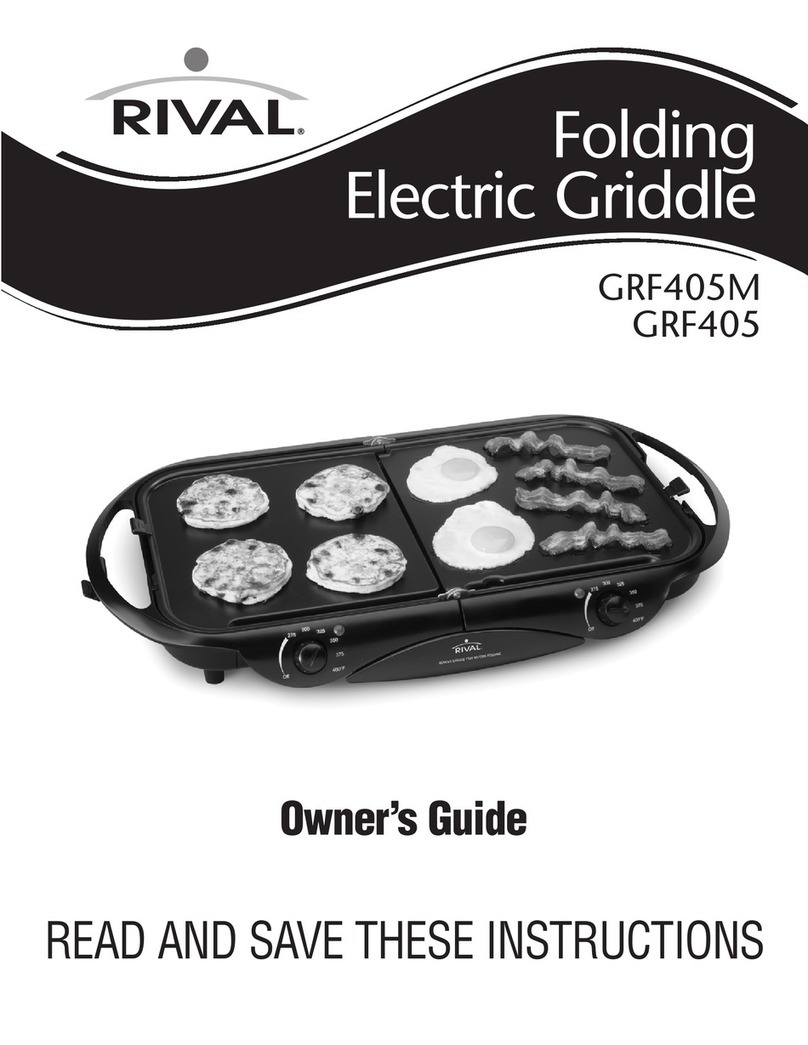
Rival
Rival GRF405M owner's guide
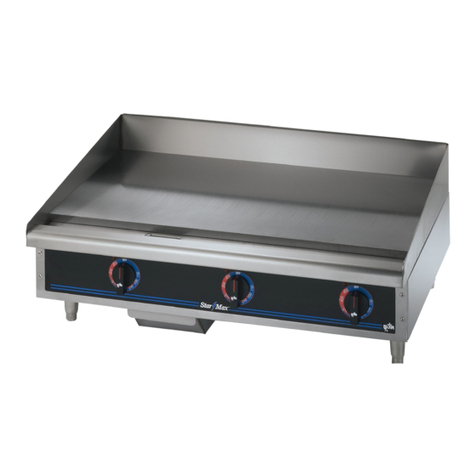
Star
Star Star-Max 536TGD-230V Installation and operation instructions

Blue Seal
Blue Seal Evolution GP516 Installation and operation manual
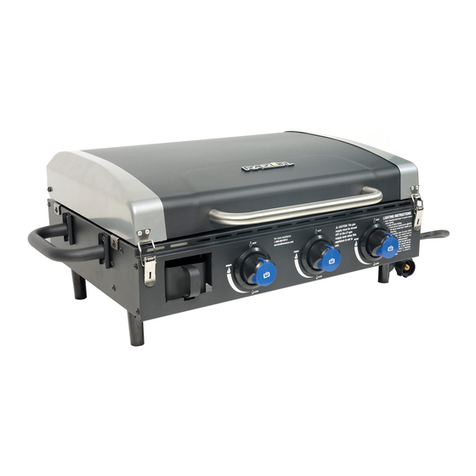
Razor
Razor GGC2228MG owner's manual

Elma
Elma PA4727 quick start guide
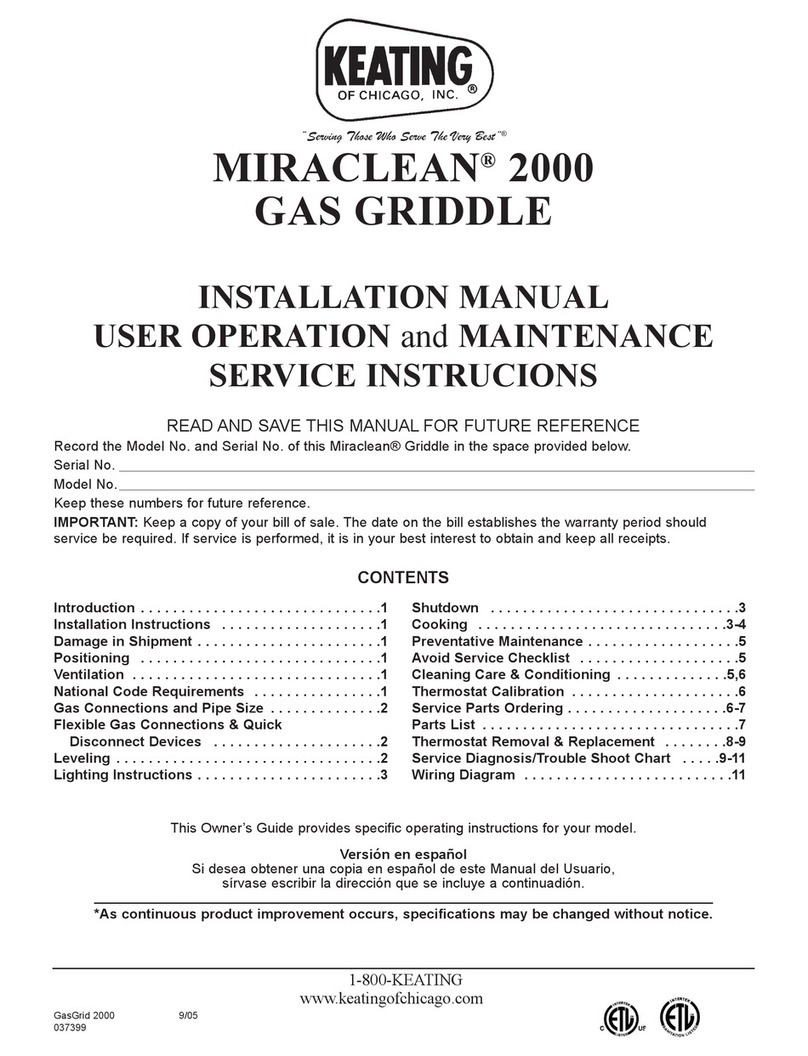
Keating Of Chicago
Keating Of Chicago Miraclean 2000 installation manual

Southbend
Southbend Platinum Series Installation & operation manual
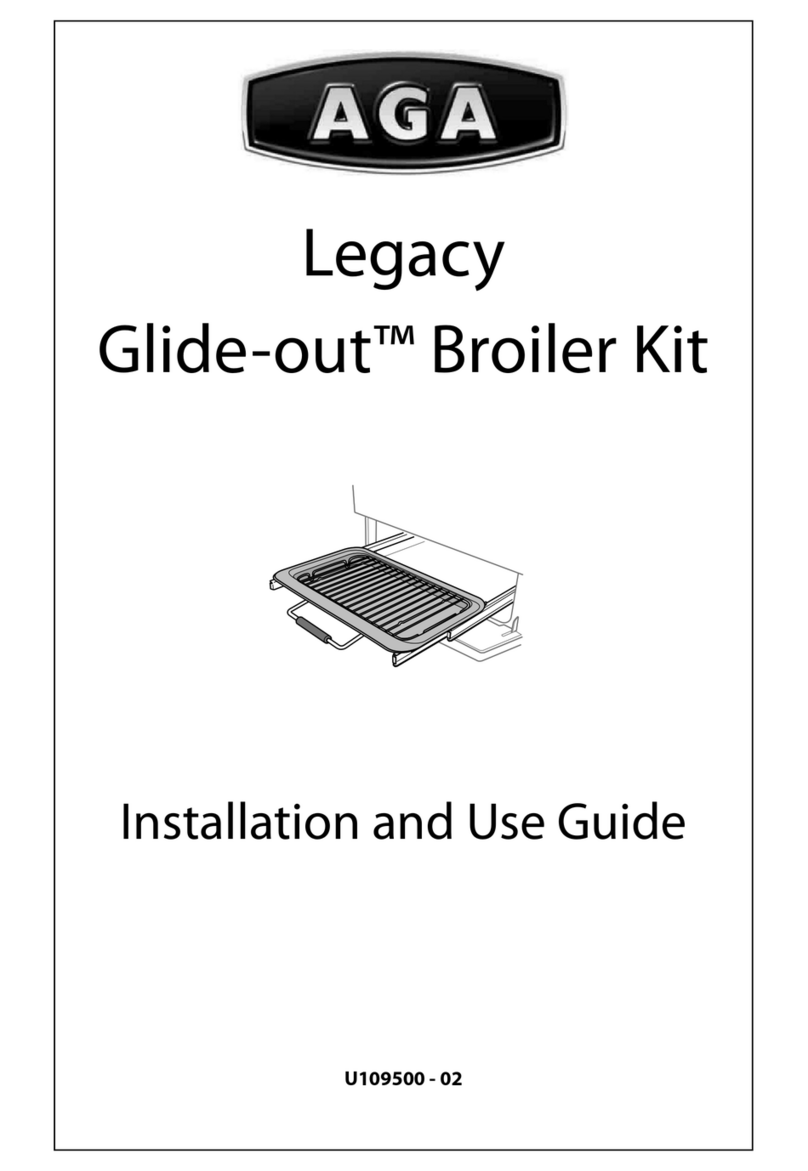
AGA
AGA Glide-out Installation and use guide
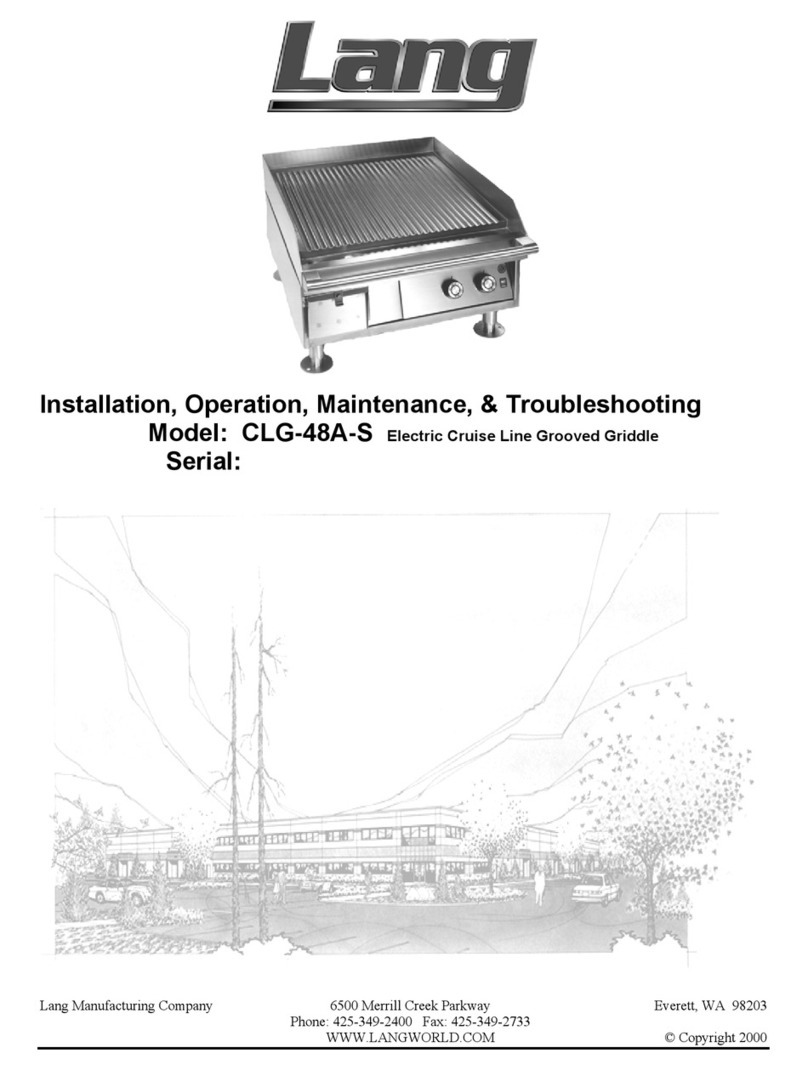
Lang
Lang CLG-48A-S Installation, operation, maintenance, & troubleshooting
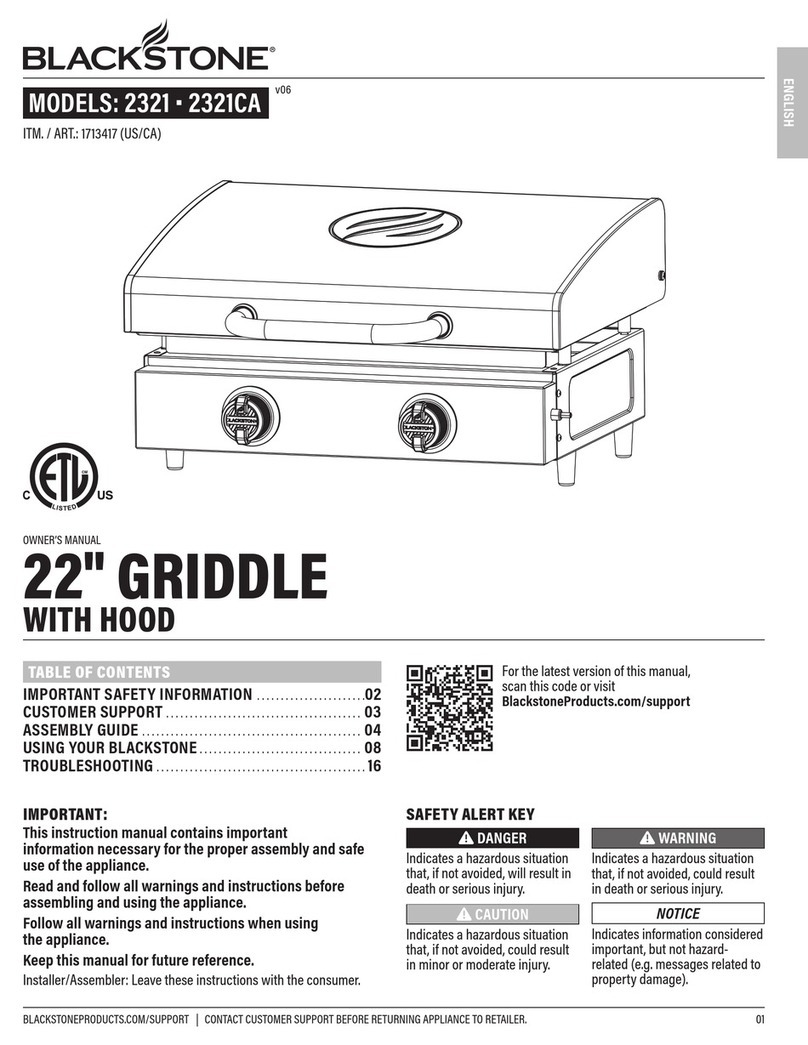
Black Stone
Black Stone 2321 owner's manual
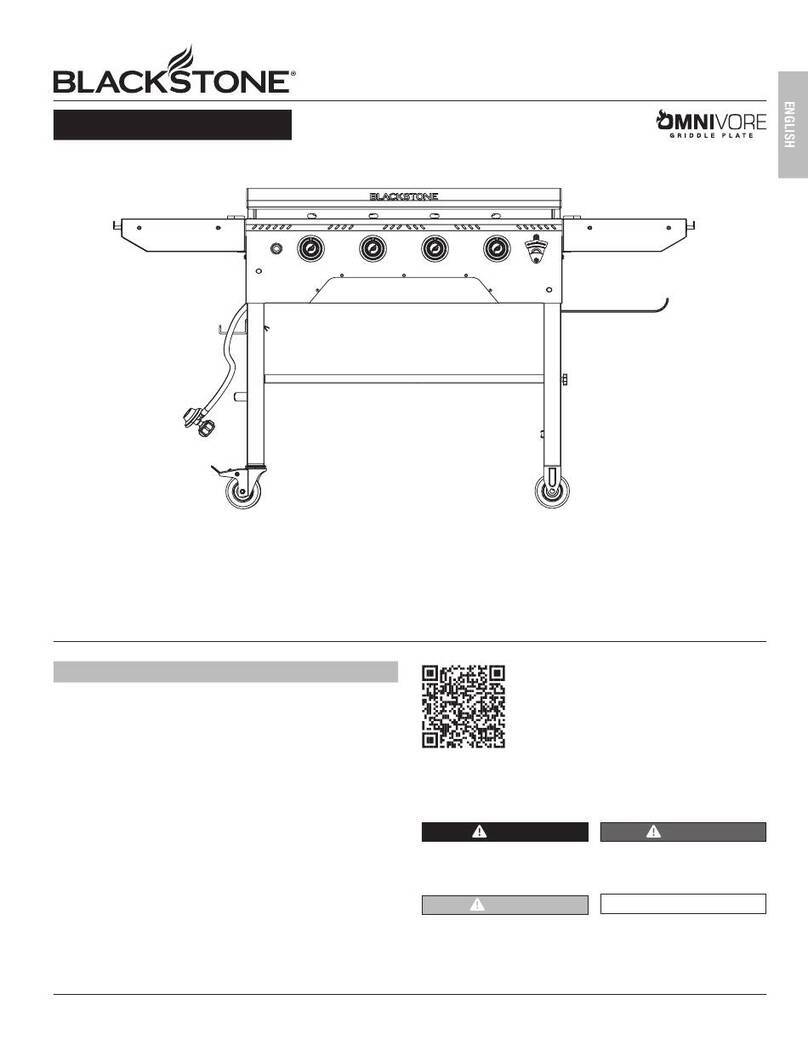
Black Stone
Black Stone 2210 owner's manual
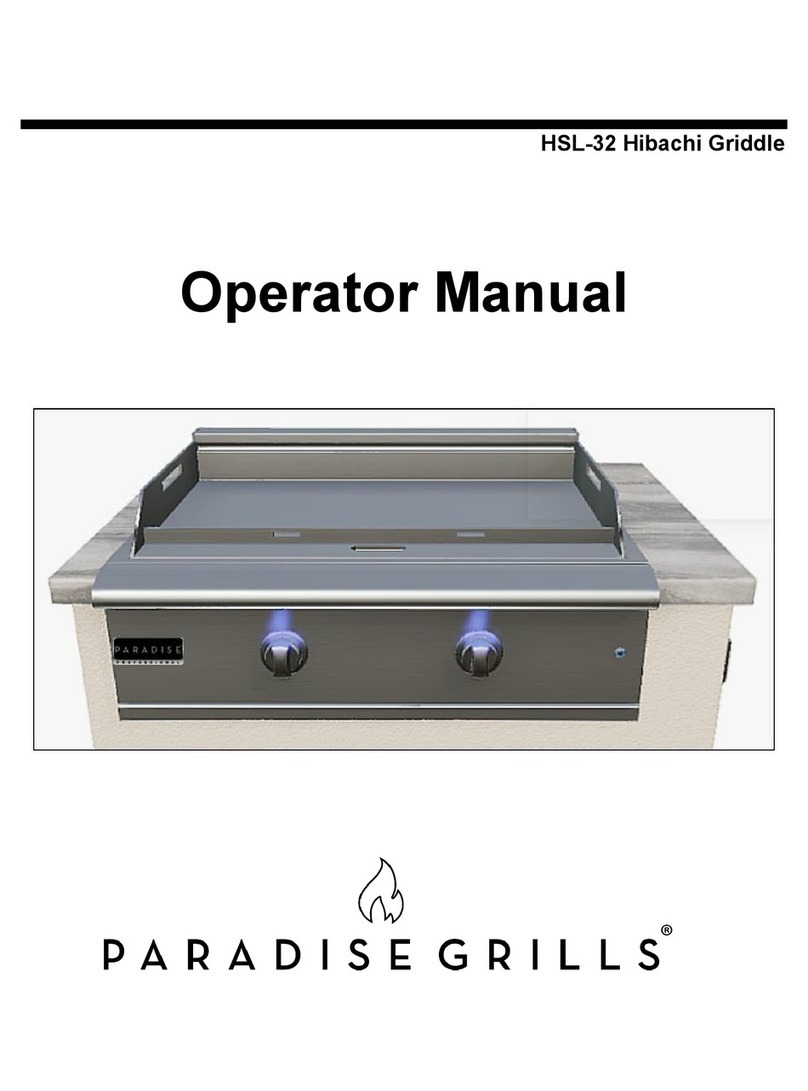
PARADISE GRILLS
PARADISE GRILLS HSL-32 Operator's manual

